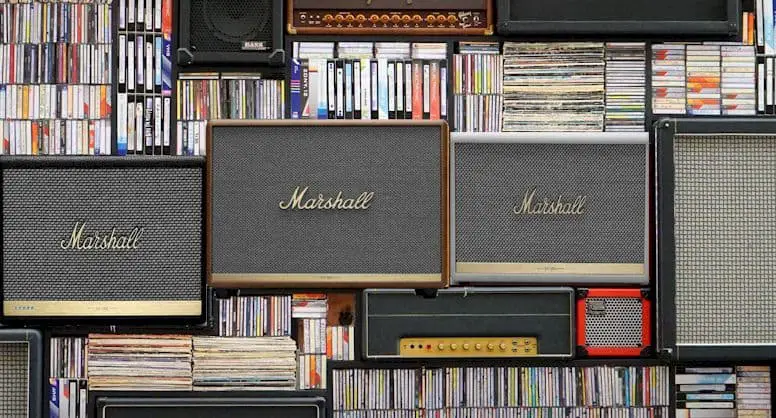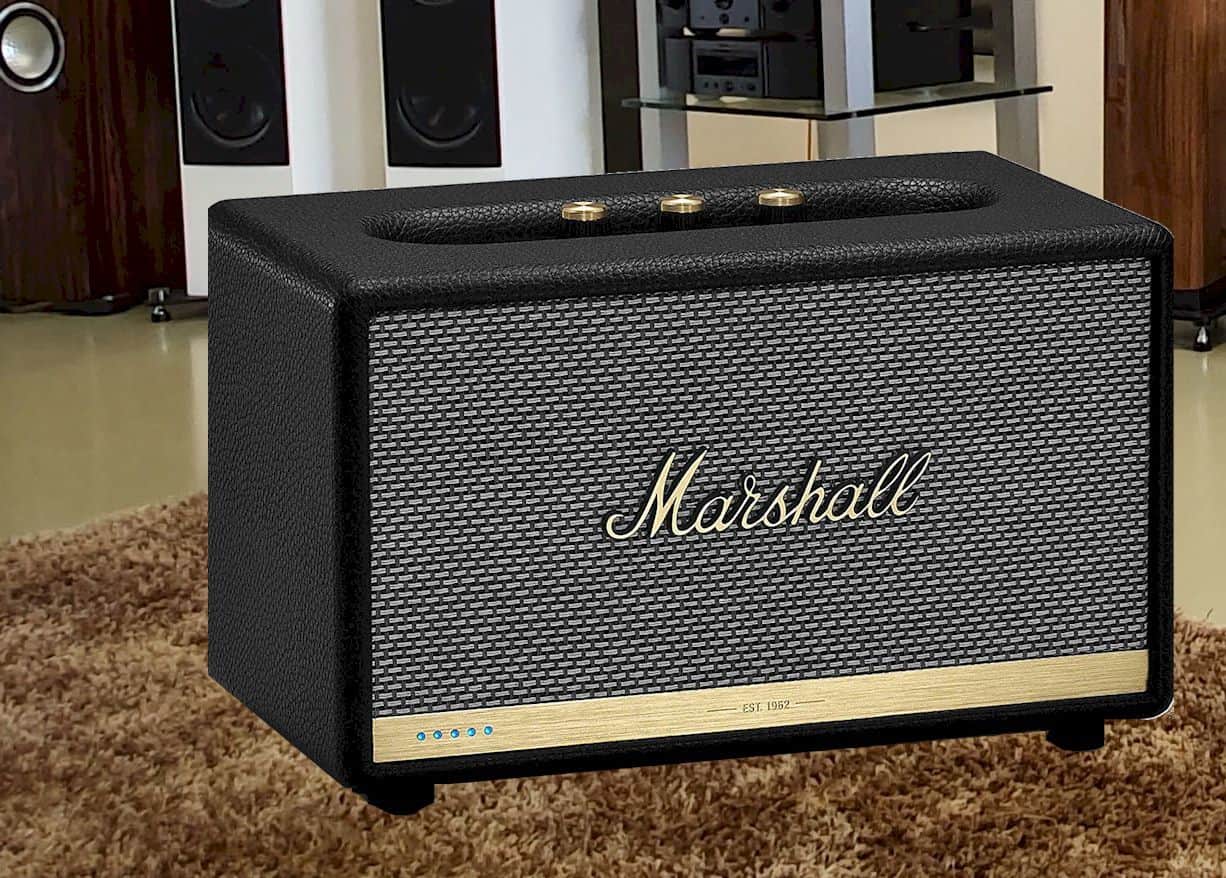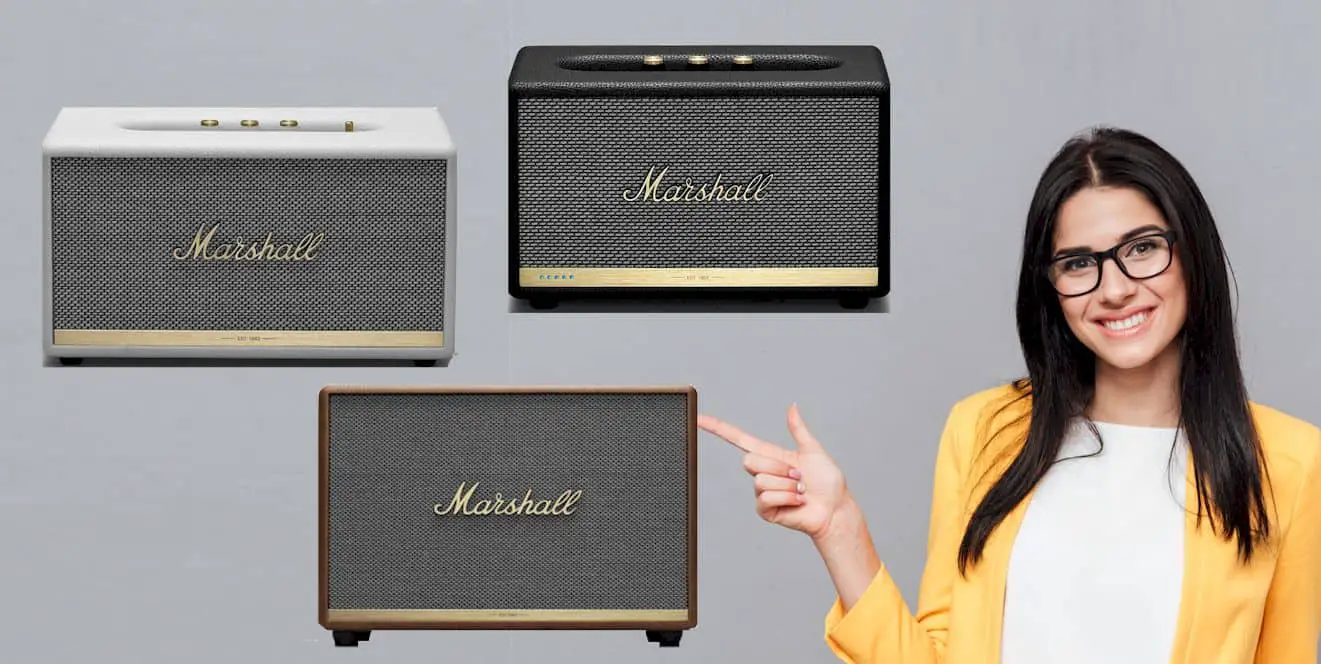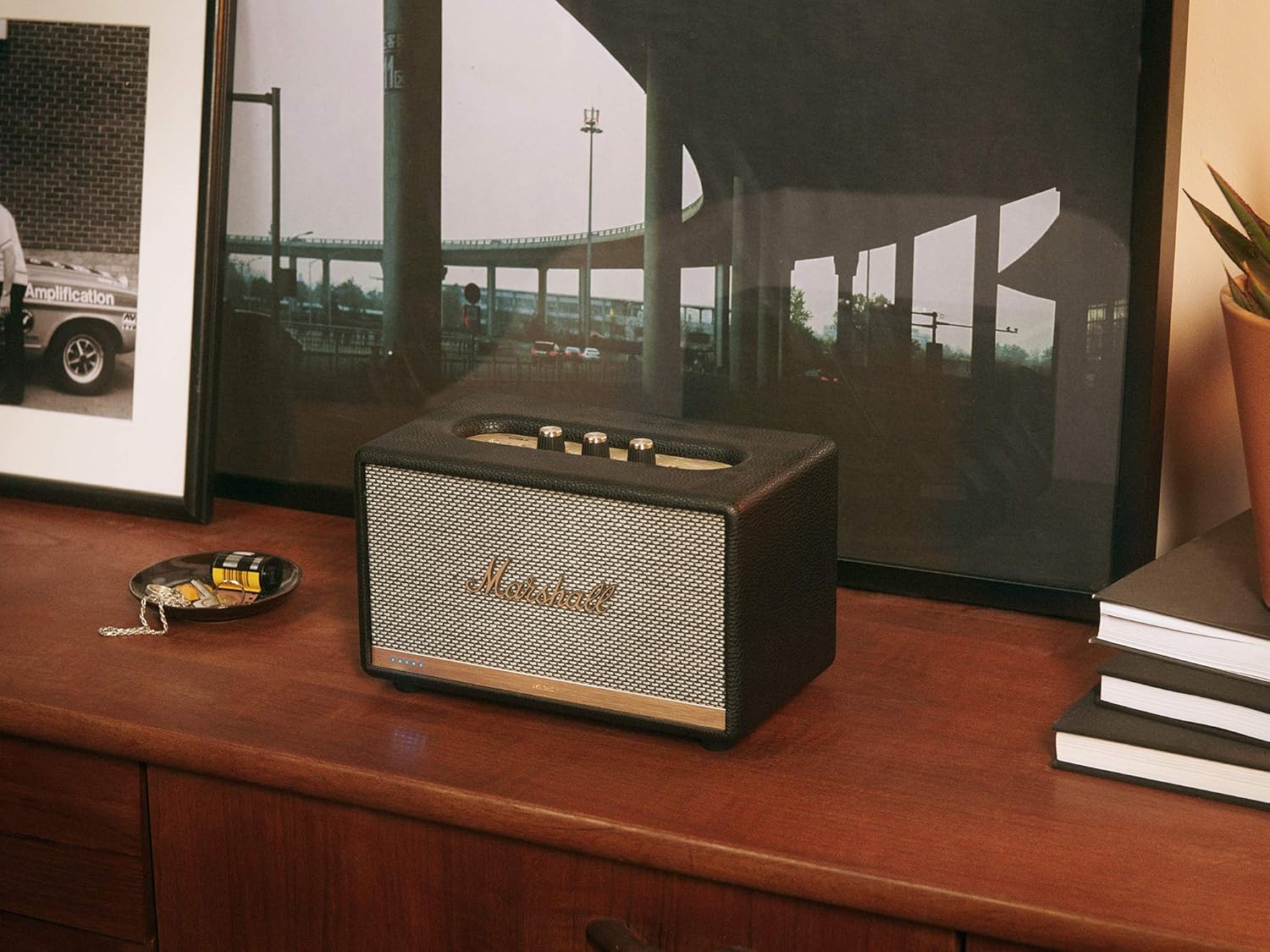Despite the stiff competition in the highly competitive speaker market today, Marshall speakers have succeeded in gaining popularity. The steady rise in popularity is seen to continue even in the coming years.
This post aims to come up with a thorough evaluation and comparison of Marshall Acton II vs. Stanmore II vs. Woburn II. Which one is best for you? Although coming from the same manufacturer and possessing a lot of common features, each model has some unique features in terms of audio performance and design.
Marshall Action II | Marshall Stanmore II | Marshall Woburn II | |
|---|---|---|---|
Dimensions | 10.24x6.3x5.91” | 13.78x7.68x7.28” | 15.75x12.20x7.87” |
Weight | 4.53 lbs. | 10.25 lbs. | 18.85 lbs |
AC Input Power | 100 to 50 / 60 Hz | 100 to 240 VAC, 50 / 60 Hz | 100 to 240 VAC, 50 / 60 Hz |
Speaker Configuration | 2-Way | 2-Way | 2-Way |
Color | Black, white, & Brown | Black, white, & Brown | Black, white, & Brown |
Frequency Response | 50Hz to 20kHz | 50Hz to 20kHz | 50Hz to 20kHz |
Maximum Sound Level | 98 dB @ 1m | 101 dB @ 1m | 110 dB @ 1m |
Woofer | 30W | 50W | 50W (2x) |
Tweeters | 15W (2x) | 15W (2x) | 15W (2x) |
Amplifier Power Rating | 60 W | 60 W | 130 W |
Amplifier Class | 3 x Class-D | 3 x Class-D | 4 x Class-D |
Wireless Connection | Bluetooth 5.0 | Bluetooth 5.0 (Qualcomm apt X) | Bluetooth 5.0 (Qualcomm apt X) |
Connectivity Range | 30’ | 30’ | 30’ |
Wired Connection | 3.5mm input | 3.5mm and RCA input | 3.5mm and RCA input |
Let's begin by taking a glance at a comparison chart of the three models. This way, you can see why these speakers are quite popular today. Next, we’ll examine each Marshall wireless speaker individually. In the end, we will provide a recommendation on which Bluetooth speaker is ideal for your particular preference and needs.
Contents
Marshall Bluetooth Speakers Reviews
Architectures of The Marshall Bluetooth Speakers

Compared to speakers from other brands, it is easy to notice that the Marshall Bluetooth speaker stands out. Each one is as elegant and aesthetically pleasing as the other. However, when choosing the right model, you need to consider a few things, including the weight and dimension.
Based on the comparison chart above, Marshall speakers come in different sizes. If dimension and/or weight is crucial for you, take a look at Marshall’s lightest and smallest model – the Marshall Action II. Sure, you can find a handful of portable speakers from other manufacturers of the same weight and size, but the Marshall model arguably is more pleasing to the eye.
Marshall Woburn II is much bigger in stature. It is as much as 4x larger than Marshall Action II. It is therefore important that you first think long and hard when choosing between these two models.
If you prefer something that lies somewhere in the middle, then the Marshall Stanmore II might fit your needs. It is neither the biggest nor the smallest among the siblings, and it would be the optimal choice if you are looking for a speaker that is big enough, but short of being humongous such as Woburn II. It is also worth mentioning that the speaker’s size has a bearing on its cost. The bigger the speaker size, the more expensive it becomes.
In terms of design, the dimensions and weight are the main difference between the three Marshall speakers. As mentioned, they share a lot in common. They are all available in 3 colors, namely black, brown, and white.
It would be difficult to find a more beautifully designed speaker on the market today than the Marshall Wireless speaker models.
On the front side of the speakers, you will find the iconic Marshall Logo as well as the woven grille. This is perhaps one distinct feature that Marshall will continue to provide in the years to come.
Summing it up, Marshall speakers will surely complement the overall look of your home. Expect to receive compliments from family, friends, and other visitors because of your speaker’s aesthetics.
Other than the logo and woven grille along with the front panel, there are other iconic things that distinguish the Marshall speakers from the rest. These include the three knobs at the top intended for the volume and the bass and treble. These buttons allow you to customize the speaker to produce the exact sound you prefer.
The red LED lights will turn on whenever any function, including the knobs, are switched on. On the left side, you’ll find the AUX Jack as well as the source button. This is also known as the pairing button.
In-between, you’ll find the Bluetooth and AUX lights that will light up whenever you connect the speaker wirelessly or through a cable, respectively. The Play/Pause and Power buttons are located at the right corner. These buttons need no further explanations.
In terms of durability, it is safe to say that the speakers will not be easily damaged with normal wear and tear. Of course, it can sustain damage with improper use or if you intentionally do it. Other than that, you can expect your speaker to provide you with many years of efficient performance with proper care.

Note that newer Marshall portable speaker models like Kilburn II, Tufton, and Stockwell II come with IPX2 ratings. This means they are, to some extent, water-resistant, and can handle some splashes of water. Thus, you can carry them around even in rainy weather – with proper precaution, of course. Cover them to protect them from the elements, to always be on the safe side.
It is unthinkable, however, that you will be out on a rainy day with your Action II, Stanmore II, or Woburn II primarily because of their relatively big size and heavy weight, and you would need a power source. Nevertheless, you must not place your speaker near water – even a glass of water.
To sum it all up, water resistance is not among the strong suits of the Marshall speaker models we are evaluating.
The Marshall Bluetooth Speakers Physiognomies and Features
Not one among the three speakers featured in this review boasts of an impressive battery life. Simply put, they all need a regular power supply to sustain optimum performance. This is quite a shame considering that these portable speakers boast of their capability to produce some amazing playtime. I guess you just need to accept the fact that their batteries aren’t reliable.
Their power supply limitations notwithstanding, these speakers are flexible in terms of connectivity. They are, after all, Bluetooth speakers, and as such you can the speaker to your device wirelessly within a range of 30’. This is something that you won’t expect any problems with. Most users can attest to that. You can connect your device to the speaker hassle-free.
Also, you can plug the AUX Jack conveniently into the port found on the unit’s top left corner. The Woburn II and Stanmore II offer more options. You can connect them via RCA. They also come with Qualcomm and apt X support. But, make no mistake about it. The Action II is not inferior by any means. Despite its smaller size, it can compete in terms of performance.
Marshall Acton II vs. Stanmore II vs. Woburn II: any way you go, you can expect to get some amazing features. Each Marshall model boasts of multi-host functionality. This means you can connect the two devices via Bluetooth at the same time. The speaker also comes with the Marshall Bluetooth app that allows you to customize the audio aside from the control knobs.
You can tweak and change your EQ depending on your current mood. Amp up your listening experience the way you want. Using the app, you can make the speaker sleep or wake up. You can also change the LED lights’ intensity.
While this post isn't about the multi-room speakers from Marshall, we find it appropriate to mention some features. Multi-room functionality adds three wireless connectivity options: Spotify Connect, Chromecast built in, and Apple AirPlay. WiFI can be used as well to access Google Assistant. You can consider the multi-room options if these features matter to you.
The Marshall Bluetooth Speakers Performance
One of the most important considerations when looking for a wireless speaker is audio performance. Even if it has the most enticing and advanced features available, the speaker is worthless if its audio ability sucks. What’s great about a Marshall speaker is that it is the complete package.
The massive body serves an important purpose, which is to provide loud, big sounds. These speakers can make a loud party even louder. You can set the bass & treble using the app and the knobs. Customize the sound, whichever way will give you the most satisfaction. Simply put, everything you need is available.
The speakers’ lowest frequency is 50Hz. This is arguably low. If you need more, Woburn II offers an impressive 30Hz, and this is not something you experience daily.
The three speakers can all go quite low to produce humongous bass with high quality sound waves.
The maximum sound pressure level for Action II is 98 dB, 101 dB for Stanmore II, and 110 dB for Woburn II. The full spectrum of the speakers’ powers are impressive 60W, 80W, and 130W for the Action II, Stanmore II, and Woburn II, respectively. These specs are sufficient to enliven a loud party – even in a colossal home.
Although all three are quite powerful in terms of audio performance, and provide crisp and neat sounds, we need to single out Woburn II as the strongest just because it produces the loudest sound.
Marshall Bluetooth Speakers Comparison
As mentioned earlier, the main goal of this Marshall Acton II vs. Stanmore II vs. Woburn II review is to help you decide on the best wireless speaker for your specific needs and preferences. To do that, you need to consider various factors like size, power, and cost. Is the speaker worth every cent you spend for it?
Each of the speakers we reviewed is an excellent choice, but which one is the best for you?
Why You Should Choose the Marshall Action II
This model can be a good choice if you are buying your first Marshall speaker. It is relatively small and more affordable. It comes with most of the functional features and iconic design of the typical Marshall speaker. Unless you need a speaker that can provide you with a more powerful audio performance, Marshall II has everything you need.
Why You Should Choose the Marshall Stanmore II
If you need a speaker that is slightly bigger than Marshall II, but not too big to occupy a lot of space, then Stanmore II may be what you are looking for. It may not be as big as Woburn II, but it can provide louder sounds than Action II. It is the best choice if you are looking for something in between, particularly in terms of budget.
Why You Should Choose the Marshall Woburn II
The largest and loudest in the Marshall wireless speaker family, Woburn II also boasts of the most powerful bass. After all, size does matter. If portability and cost are non-issues for you, then there’s no reason you shouldn’t get this speaker. While Woburn II is pricier than Action II and Stanmore II, it will prove worth its expensive price. It doesn’t only boast of its massive size. It also offers an equally massive audio performance.
All three speakers are amazing and come highly-recommended. They all boast of a great design, amazing features, and most importantly, an impressive audio performance.
Conclusion
Time and again, we have reiterated that regardless of the model you prefer, you can expect an amazing and powerful experience. Each of the Marshall speakers has a timeless design and reliable features. Because all three are similar in almost all functional aspects, your choice can be decided by a few factors: price, audio performance, and size.
How powerful and how loud do you want your Bluetooth speaker to be? How much money can you afford to spend for it? Your answers will dictate the perfect speaker model for you.
For the regular user, however, we highly recommend the speaker that is in the middle ground: Marshall Stanmore II. It is neither too small nor massive. It is likewise friendlier on the budget. It is just of the right stature and price.

HI, John Andrew here. I’ve been an audiophile since I was a little kid. I’m an original member of myaudiolover . It emerged as a way for me to share my passion and knowledge for audio technology. If you’re looking for tips, techniques, and insights about audio-tech, that can enable your productions that professional edge, then MyAudioLover is the place for you!






